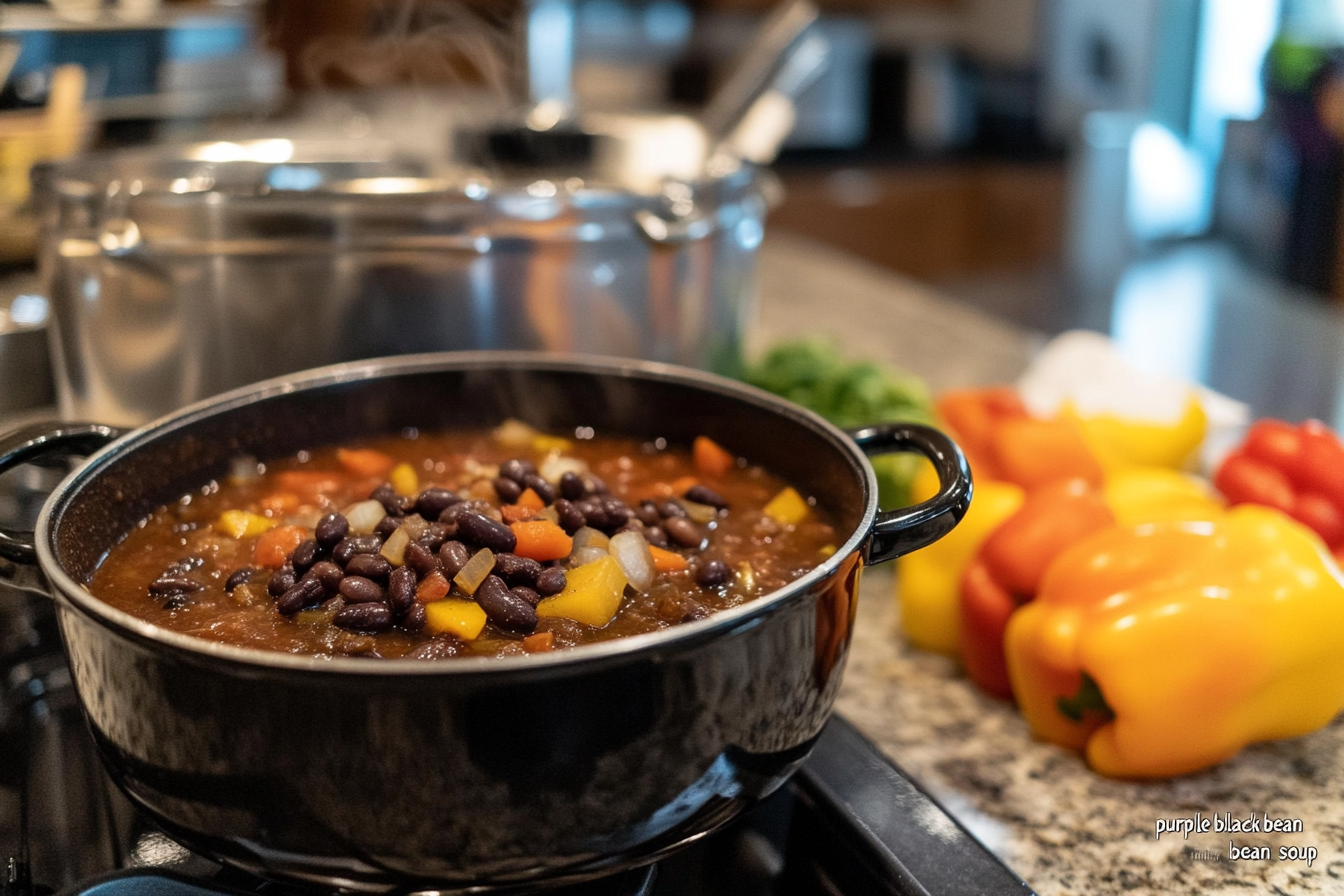When preparing Black Beans Before Making Soup, one of the most common questions is whether you need to soak the beans beforehand. While soaking beans is a traditional step in many recipes, it’s not always mandatory. This guide dives deep into the science, practicality, and culinary aspects of soaking black beans, helping you decide the best approach for your cooking needs.
What Is the Purpose of Soaking Beans?
Soaking beans before cooking has been a long-standing practice in many kitchens. But why do we soak them in the first place? Here’s an overview of its primary purposes.
Softening Beans for Faster Cooking
Dried black beans are dense and require significant time to soften during cooking. Soaking:
- Rehydrates the beans, reducing their cooking time by 25–50%.
- Makes the cooking process more energy-efficient, especially if using a stovetop.
Reducing Anti-Nutrients and Indigestible Compounds
Beans contain phytates and oligosaccharides, compounds that can:
- Reduce nutrient absorption (phytates).
- Cause bloating and gas (oligosaccharides).
Soaking helps leach these compounds into the water, which is then discarded.
Understanding Black Beans: Characteristics and Cooking Requirements
Black beans are small, glossy, and packed with flavor. However, their unique texture and density can present challenges if not cooked properly.
Texture and Density of Black Beans
- Black beans maintain their shape better than some other beans, making them ideal for soups.
- Their dense texture benefits from soaking, but they can still cook well without it using the right techniques.
Common Myths About Soaking Bean
- Myth: Beans must always be soaked.
Truth: Soaking is optional; many recipes successfully use unsoaked beans. - Myth: Soaking eliminates all anti-nutrients.
Truth: While it reduces some, cooking plays a bigger role in breaking them down.
Benefits of Soaking Black Beans
Soaking provides specific benefits that can improve the cooking process and the final dish.
Shortening Cooking Time
- Soaked beans cook faster, often taking 30–45 minutes on the stovetop versus 1–1.5 hours for unsoaked beans.
Enhancing Digestibility
- Reduces compounds that contribute to digestive discomfort.
- Creates a lighter broth with less starch, which some people prefer in soups.
Improving Flavor and Reducing Bitternes
- Soaking allows the beans to absorb water gradually, preventing overly bitter or earthy flavors from dominating the soup.
Cooking Black Beans Without Soakin
It is entirely possible to skip the soaking step when making black bean soup. Here’s how.
The Pros and Cons of Skipping the Soa
Pros:
- Saves time in meal preparation.
- Preserves a slightly firmer texture for beans in soups.
Cons:
- Requires longer cooking time.
- Can lead to thicker broth due to released starch.
- Potential for increased digestive discomfort.
Techniques for Cooking Black Beans Without Soaking
If you skip the soak, here are three reliable methods:
Pressure Cooking: A Time-Saving Alternative
- Pressure cookers, like the Instant Pot, cook unsoaked beans in 30–40 minutes.
- This method preserves flavor and texture without pre-soaking.
Slow Cooking: Achieving Tenderness Over Time
- Use a slow cooker for unsoaked beans, letting them cook on low for 6–8 hours.
- Ideal for hands-off cooking while preparing other soup ingredients.
Stove-Top Methods for Unsoaked Beans
- Simmer beans gently for 1.5–2 hours, adding water as needed to prevent burning.
- Keep the pot partially covered to retain moisture.
Common Adjustments for Non-Soaked Beans in Soup
Adjusting Liquid Ratios for Unsoaked Beans
- Unsoaked beans absorb more water, so increase liquid by 1–2 cups in your soup recipe.
Modifying Cooking Times and Heat Levels
- Cook at a steady simmer to allow even cooking and soften the beans fully.
Flavors and Seasonings: When to Add Ingredients
Why Season Late: Preventing Tough Skins
Adding salt or acidic ingredients (like tomatoes or vinegar) early can prevent beans from softening. Wait until beans are fully tender before adding these.
Infusing Flavor with Aromatics During Cooking
Include onions, garlic, bay leaves, or whole spices while the beans cook to enhance the soup’s flavor from the start.
Practical Tips and Considerations
Deciding whether to soak black beans for soup depends on your schedule, preferences, and equipment. Here are some tips to guide your decision.
When to Soak: Key Scenarios
Large Batches or Meal Prep
Soaking is recommended when cooking large quantities to save time and ensure even cooking.
Time-Restricted Cooking Environments
If time is limited, skip the soak and use a pressure cooker for efficient results.
Pre-Soaking Methods and Their Variations
Traditional Overnight Soak
- Rinse beans thoroughly.
- Cover with 3–4 inches of water and let soak for 8–12 hours.
- Drain and rinse before cooking.
Quick Soak Technique: Boil and Rest
- Bring beans and water to a boil.
- Turn off heat, cover, and let sit for 1 hour.
- Drain and rinse to continue cooking.
Cold Soak vs. Hot Soak: Which Works Best?
- Cold Soak: Preserves the beans’ shape but takes longer.
- Hot Soak: Speeds up the process and softens beans faster.
Avoiding Common Pitfalls in Bean Preparation
Why Do Beans Sometimes Remain Hard?
- Older beans or those stored improperly may never fully soften.
- Hard water with high mineral content can also interfere with cooking.
Addressing Cloudy or Bitter-Tasting Broth
- Rinse beans thoroughly before cooking to remove residual dust or compounds.
- Add a splash of lemon juice or vinegar to brighten the soup’s flavor.
Frequently Asked Questions (FAQs)
1. How Long Do Black Beans Take to Cook Without Soaking?
Unsoaked black beans typically take:
- 1.5–2 hours on the stovetop.
- 30–40 minutes in a pressure cooker.
2. Does Soaking Black Beans Impact Nutritional Value?
Soaking slightly reduces some nutrients like water-soluble vitamins but improves digestibility and absorption of minerals by reducing phytates.
Further Tips for Cooking Black Beans for Soup
Here are additional tips to make your black bean soup even better, whether or not you soak your beans.
1. Boosting Flavor Profiles in Black Bean Soup
Black beans have a mild, earthy flavor that can be enhanced with the right seasoning and techniques:
- Caramelized Aromatics: Sauté onions, garlic, and bell peppers in olive oil or butter before adding beans to create a rich flavor base.
- Spices: Add cumin, smoked paprika, chili powder, or coriander to deepen the soup’s taste.
- Herbs: Fresh cilantro, thyme, or bay leaves complement black beans beautifully.
- Acidity: Finish with a splash of lime juice, apple cider vinegar, or balsamic vinegar to balance the richness.
2. How to Adjust Soup Consistency
Whether you prefer a thicker or thinner soup, here’s how to achieve the desired texture:
- Thicker Soup:
- Mash a portion of the cooked beans with a potato masher or blend a cup of the soup and stir it back in.
- Reduce the liquid slightly during cooking.
- Thinner Soup:
- Add more broth or water as needed, especially if cooking unsoaked beans, which absorb more liquid.
3. Creative Add-Ins for Black Bean Soup
Take your soup to the next level with creative mix-ins:
- Proteins: Add shredded chicken, sausage, or tofu for extra protein.
- Vegetables: Corn, diced tomatoes, sweet potatoes, or zucchini provide flavor and nutrition.
- Grains: Stir in cooked quinoa, farro, or rice for a hearty meal.
4. Garnish Ideas for Serving Black Bean Soup
The right toppings can elevate your soup presentation and taste:
- Classic Garnishes: Sour cream, shredded cheese, diced avocado, or tortilla chips.
- Fresh Options: Chopped cilantro, green onions, or radishes add brightness.
- Heat and Spice: Add sliced jalapeños, hot sauce, or a sprinkle of cayenne pepper for a spicy kick.
5. Tips for Cooking in Hard Water
Hard water can interfere with beans softening during cooking. To counter this:
- Add a pinch of baking soda to the cooking water (1/8 teaspoon per cup of beans). This reduces the effects of calcium and magnesium in hard water.
- Use filtered or bottled water for soaking and cooking.
6. How to Save Time with Meal Prep
- Cook Large Batches: Prepare a large pot of beans and freeze them in 1–2 cup portions for future recipes.
- Season After Freezing: Cook beans with minimal seasoning, then customize flavors based on the soup you’re making.
7. Tips for Faster Cooking
- Preheat Water: Start cooking beans in already boiling water or broth to jump-start the process.
- Smaller Beans: Choose smaller-sized black beans, which cook faster than larger varieties.
8. Making Black Bean Soup Creamy
If you want a creamy soup without adding cream or dairy:
- Blend Partially: Use an immersion blender to blend some of the beans and broth while keeping the rest intact.
- Add Coconut Milk: Stir in a can of coconut milk for a velvety texture and subtle sweetness.
- Use Greek Yogurt: Swirl in a dollop of plain Greek yogurt before serving.
9. How to Handle Leftovers
- Refrigerate: Store leftover soup in an airtight container in the fridge for up to 5 days.
- Freeze: Allow soup to cool completely before freezing in individual portions. Use freezer-safe bags or containers for storage.
- Reheat Gently: Reheat soup on the stovetop over low heat, adding a splash of water or broth to restore its consistency.
10. Experiment with Bean Blends
While black beans are the star, combining them with other beans can create a unique soup:
- Pinto Beans: Add a creamy texture and earthy flavor.
- Kidney Beans: Introduce a heartier bite.
- Chickpeas: Offer a nutty flavor and interesting texture.

